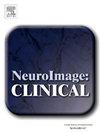Neural processing of social reciprocity in autism
IF 3.6
2区 医学
Q2 NEUROIMAGING
引用次数: 0
Abstract
Social reciprocity and interpersonal synchrony implicitly mediate social interactions to facilitate natural exchanges. These processes are altered in autism, but it is unclear how such alterations manifest at the neural level during social interaction processing. Using task-based fMRI, we investigated the neural correlates of interpersonal synchrony during basic reciprocal interactions in a preregistered study. Participants communicated with a virtual partner by sending visual signals. Analyses showed comparable activation patterns and experienced synchrony ratings between autistic and non-autistic participants, as well as between interactions with virtual partners who had high or low synchronous responses. An exploratory whole brain analysis for the effect of task revealed significant activation of the inferior frontal gyrus, insular cortex, and anterior inferior parietal lobe; areas associated with cognitive control, rhythmic temporal coordination, and action observation. This activation was independent of the virtual partner’s response synchrony and was similar for autistic and non-autistic participants. These results provide an initial look into the neural basis of processing social reciprocity in autism, particularly when individuals are part of an interaction, and hint that the neural processing of social reciprocity may be spared in autism when their partners’ behavior is predictable.
自闭症患者社会互惠的神经加工
社会互惠和人际同步性隐含地调节社会互动,促进自然交流。这些过程在自闭症中发生了改变,但尚不清楚这种改变是如何在社会互动处理的神经水平上表现出来的。使用基于任务的功能磁共振成像,我们在一项预先登记的研究中调查了基本互惠互动中人际同步的神经相关。参与者通过发送视觉信号与虚拟伙伴交流。分析显示,自闭症和非自闭症参与者之间的激活模式和经历的同步评级,以及与具有高或低同步反应的虚拟伴侣之间的互动,都具有可比性。对任务效应的探索性全脑分析显示,额下回、岛叶皮层和前下顶叶显著激活;与认知控制、节奏时间协调和动作观察有关的区域。这种激活与虚拟伴侣的反应同步无关,在自闭症和非自闭症参与者中是相似的。这些结果初步揭示了自闭症中处理社会互惠的神经基础,特别是当个体是互动的一部分时,并暗示当他们的伴侣的行为是可预测的时,自闭症中处理社会互惠的神经处理可能会被免除。
本文章由计算机程序翻译,如有差异,请以英文原文为准。
求助全文
约1分钟内获得全文
求助全文
来源期刊

Neuroimage-Clinical
NEUROIMAGING-
CiteScore
7.50
自引率
4.80%
发文量
368
审稿时长
52 days
期刊介绍:
NeuroImage: Clinical, a journal of diseases, disorders and syndromes involving the Nervous System, provides a vehicle for communicating important advances in the study of abnormal structure-function relationships of the human nervous system based on imaging.
The focus of NeuroImage: Clinical is on defining changes to the brain associated with primary neurologic and psychiatric diseases and disorders of the nervous system as well as behavioral syndromes and developmental conditions. The main criterion for judging papers is the extent of scientific advancement in the understanding of the pathophysiologic mechanisms of diseases and disorders, in identification of functional models that link clinical signs and symptoms with brain function and in the creation of image based tools applicable to a broad range of clinical needs including diagnosis, monitoring and tracking of illness, predicting therapeutic response and development of new treatments. Papers dealing with structure and function in animal models will also be considered if they reveal mechanisms that can be readily translated to human conditions.
 求助内容:
求助内容: 应助结果提醒方式:
应助结果提醒方式:


